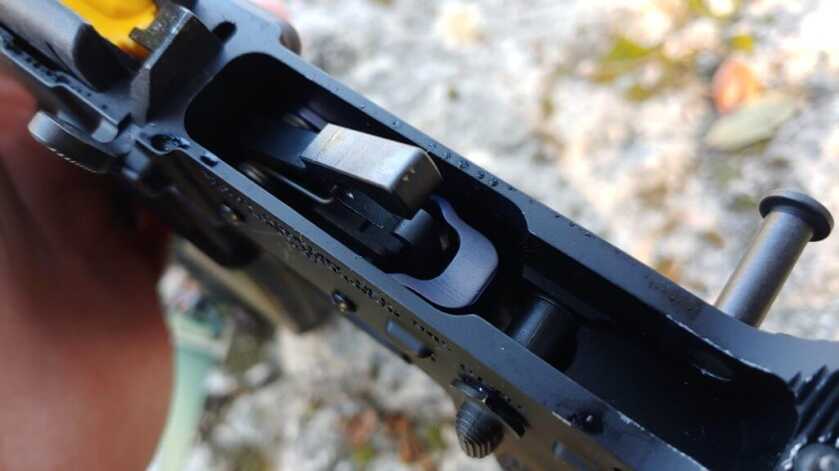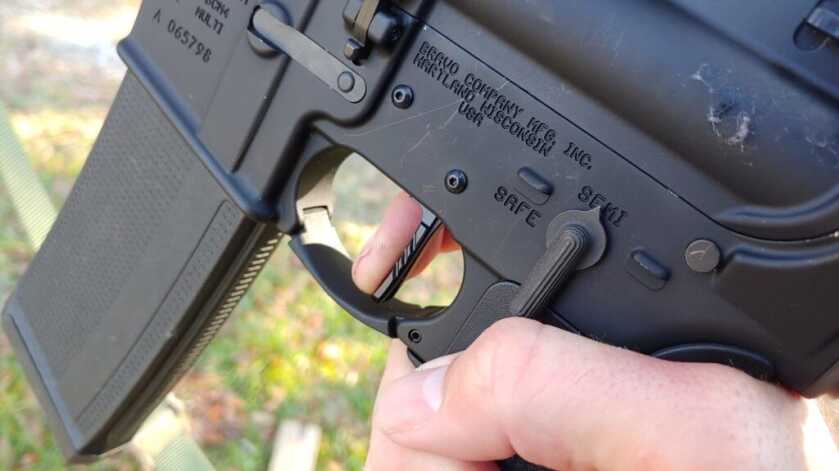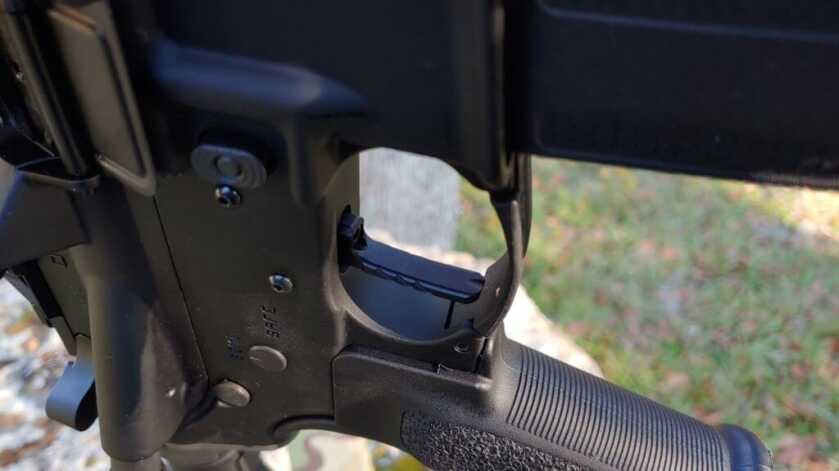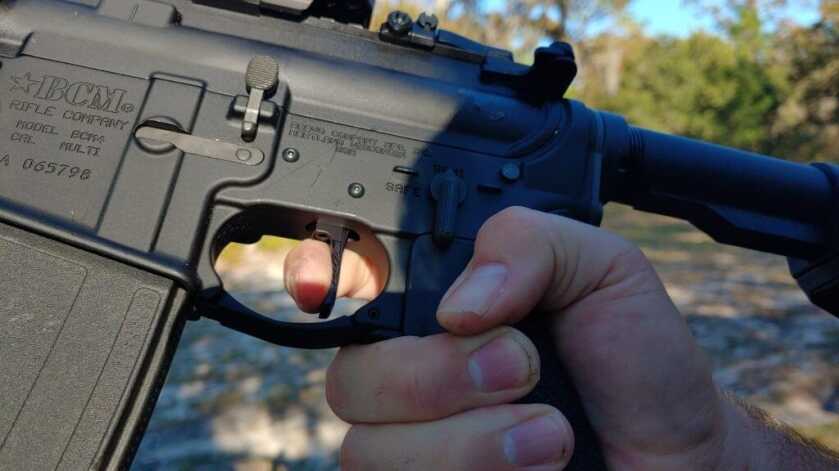I love the modularity of the AR-15 rifle. It’s such an excellent platform with more aftermarket support than any other rifle on the market. The aftermarket can make a very simple rifle into nearly anything you want it to be. From a home defense carbine to a designated marksman’s rifle. You can swap and upgrade roughly everything, including the trigger. Today we are talking about a new trigger on the market called the RMT Nomad.
I can already hear your eyes roll. Great, another drop-in trigger for the AR-15, that’s what, the 15th million one? Well, yes, it is a drop-in trigger, but it’s a fair bit different than any other trigger on the market. I mean, it does come with the easy install nature of a drop-in trigger, and it’s a lighter, more improved trigger, but that’s where it stops! This ties back to the name, Nomad.
The RMT Nomad
So what exactly is a Nomad? A Nomad is someone with no permanent home. They travel all the time and rarely stay in one place for very long. The RMT Nomad trigger keeps to the Nomad name. It doesn’t have to stay in one place. I don’t mean you can swap it out and move it from gun to gun. What I mean is that the trigger itself moves.

“Well, duh, all triggers move forwards and rearwards!” Yes, that’s true, but how many triggers move right and left? As far as I know, only the RMT Nomad is the only trigger that moves left to right. Shooters can pivot and rotate 6 degrees, and it moves left to right.
What’s the point? Honestly, at first, I didn’t know. To be completely honest, I got the trigger and installed it without really understanding the concept myself. However, after some dry fire, some range time, and handing the rifle to multiple shooters, I’ve figured it out.
Installing the RMT Nomad
I installed the RMT Nomad into my favorite AR 15, which is a mix of a Colt upper and a BCM lower. My crappy mill job on my 80% lower would allow it. The trigger was already quite fantastic, so I was interested to see just how much the Nomad could improve on. Installation was easy. Pop out the safety, the trigger group, dump the Nomad in, and replace the safety.

The Nomad comes with anti-walk pins and the small Allen key to install them. After about five minutes, I had the trigger installed and ready for action. The MSRP of the RMT Nomad is $279.00, and it is made in the United States. RMT promises a 3-pound trigger pull, and the trigger is not adjustable.
Live Fire With the Nomad
With the Nomad installed and the function tested, I headed to the range. I brought my Lyman trigger scale and measured the trigger before loading up. The three-pound promise was met, and the RMT Nomad broke consistently at 3 pounds. Manual trigger scales aren’t the best, but ten pulls each resulted in a 3-pound measurement.

The first shots proved just how nice the RMT nomad is as a trigger. The flat-faced metal trigger greets the finger with a rather long trigger design. Vertically you can place your trigger finger anywhere and have comfortable engagement with the trigger. The Nomad’s reset is short, sweet, and positive. You can hear and feel when the trigger breaks, and it feels fantastic.
That short and light pull is always very smooth and grit-free. There is no grinding or sand-like feeling in the trigger. There is the press, maybe a fractional take up, then the bang.

A light trigger with a short reset makes rapid-fire easier. Not only can I fire faster, but the light and smooth trigger make rapid-fire accurate. I noticed a noticeable difference between the accuracy of my double taps after I swapped triggers. I ran drills like the VTAC 1-5, which involves firing multiple, ever-increasing strings of fire on numerous targets.
The RMT Nomad helps keep those long strings of four and five rounds accurate and controllable. I blazed through the drill with the rounds staying center in the Z zone of my target and scored a 3.4 second run time. I’m no pro shooter, but that’s a great time for me.
Moving About
Okay, now let’s talk about the pivoting design. It’s a great trigger without the pivot, but is the pivot just a gimmick? Bottom line up front, I have better trigger control with the RMT Nomad.
When I was firing that VAC 1-5 drill, I didn’t realize I had even moved the trigger. When I finished the drill, I found the trigger pushed all the way to the left with the tip of my finger remaining on the trigger.

That pivoting nature keeps me from ever using too much finger on the trigger and throwing my shots. I have big hands, and being able to keep the tip of my finger on the flat face of the trigger comfortably feels fantastic. The trigger allows me to have the most natural grip on my gun.
Whenever I grab the gun, the trigger goes precisely where my finger wants it to. That translates into a cleaner break and increased accuracy. I have more control over the trigger, and it feels like I can engage the trigger with greater speed and control. I can mindlessly maintain a consistent trigger press due to the pivoting nature.

I handed the RMT Nomad to my wife and a friend and didn’t mention the pivoting design. When they finished shooting, I showed them how exactly the trigger functioned, and both were a fair bit surprised about where the trigger ended up. My wife’s petite hands pulled the trigger just slightly towards her shooting hand, and my friend’s larger hands kicked it out to the left.
Pewing and Powing
The RMT Nomad provides AR shooters with an outstanding trigger, with and without the pivoting design. It’s smooth, light, and has a great reset. The pivoting Nomad trigger is more than a gimmick. The trigger excels in granting you a more ergonomic trigger and a more controllable trigger. Color me surprised, and I’m interested in what RMT does next. If you have big hands, I really suggest you give the Nomad a try; it’s made me not want to go back to standard triggers.


I too, have meat hooks for hands, and it’s a common problem to put too much finger on the trigger… ESPECIALLY with a small frame pistol. This new trigger may be the perfect answer for some folks, and that’s great! I instead, will continue to focus on the imperative mechanical/muscle-memory skills of proper grip, sight-alignment, and trigger control. This provides accurate and “fast-enough” shot placement with any firearm.